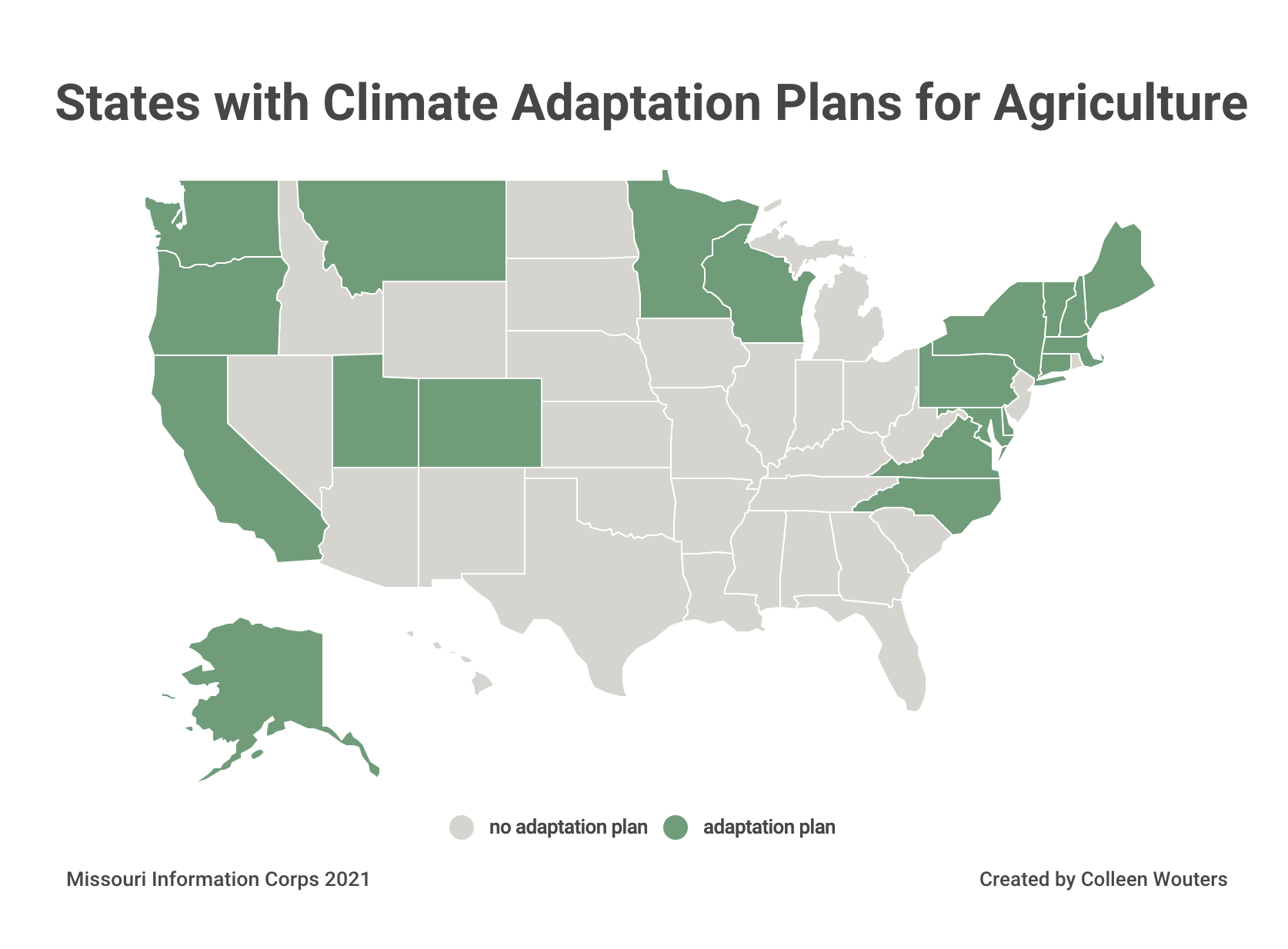Without an official statewide climate plan, Missourians must look elsewhere for direction

A staple of industry and identity in the state — agriculture has a stake in Missouri’s economy and people’s livelihoods.
But Missouri’s agriculture industry will face the harsh realities of the climate emergency if action isn’t taken. The Fourth National Climate Assessment by the U.S. Global Change Research Program states that in the Midwest, climate change will reduce agricultural productivity in the next 30 years due to increased precipitation and extreme temperatures. That is, unless there are major technological advances.
Not only will more rain cause less flexibility for spring planting and worsen soil erosion, but higher overall temperatures will also reduce yields for staple crops in Missouri like corn and soybeans.
Although some states have taken initiative to combat climate change, Missouri is one of 30 that has not created a statewide plan to prepare for potential climatic changes. And though Missouri has an $88 billion agricultural industry, the Missouri Department of Agriculture (MDA) does not have a climate adaptation plan for farmers.
In a written statement, MDA Communications Director Sami Jo Freeman recognized the department’s lack of a climate change adaptation program. She explained that “research and education on how to cope with the changing climate primarily lies with the University of Missouri-Extension program.”
Marshall Stewart, the director of the MU Extension program, said that its goal is to provide farmers with research-based information that originates from the University of Missouri. The research faculty works in crop and livestock areas, agribusiness, the environment and many other fields.
“We’re providing farmers and ranchers information that is research and science-based that provides those best [agricultural] practices to withstand something that’s changing in the environment, be it flooding, drought, or what have you,” Stewart said.
The MDA is a state regulatory agency, meaning programs and initiatives by the department have to be proposed to the Missouri legislature and then approved before they can be implemented.
Rep. Tracy McCreery (D-Olivette), a member of the Agricultural Policy committee, said that to her knowledge, there hasn’t been anyone pushing for a climate change adaptation for agriculture from the Missouri legislature’s executive leadership or otherwise.
“In this state, there seems to be a resistance to having an honest conversation about the changes we’re seeing in the climate,” McCreery said. “The reality is that we’re seeing changes, so let’s work as a team to address those changes, and I do not see that happening in the legislature.”
Stewart said that the MU Extension program is constantly working with the MDA “to figure out new ways to educate producers so that they have the information they need to adjust to whatever new standards may be in any particular area of agriculture.”
Garrett Hawkins, former deputy director of the MDA and current president of the Missouri Farm Bureau, explained that the MDA hadn’t supplied any direct funding for the purpose of studying climate change throughout his time there, which was between 2017 and 2019.
“But we did take a proactive stance, as a department, by building partnerships to focus on innovations in production agriculture,” Hawkins said. He is describing precision farming, which explores how new technologies can be used to increase crop yields and profits while lowering the amount of land, water, fertilizer, herbicides and other resources needed to farm. This in turn puts less stress on the environment by cutting down the amount of resources used.
Hawkins said the Missouri Farm Bureau also references the MU Extension program as education and outreach on the changing climate. This education could be information on how to understand a soil health report, which fertilizers are environmentally safe or how a drought can affect corn crops.
According to a report by the States at Risk Project, a project that looks at climate threats for each of the 50 states and the actions taken to combat those threats, Missouri was graded an F on its climate change preparedness by the lack of policies put in place by the state.
It states that, “though Missouri has a plan to address current threats with its Enhanced State Hazard Mitigation Plan, Missouri is taking roughly no action to assess, plan for and implement preparedness steps in response to future climate risks.”
This plan outlines state responses to natural disasters like wildfires, floods and earthquakes.
There are currently 20 states with statewide climate adaptation plans that cover agriculture, health and infrastructure adaptations.
Climate adaptation plans for agriculture, when implemented, can do several things. They lower costs for local governments in regards to climate-related events, lower risks for farmers and agricultural businesses and help with the conservation of soil and water.
These plans can include recommendations on land management practices to reduce greenhouse gas emissions, guidelines on water conservation and goals for carbon sequestration.
To take advantage of the outreach about improved agricultural practices from the MU Extension program, visit their website here. Visit MoSoy or MoCorn to learn more about the state’s major commodities and ask questions.
If you are interested in learning more about Missouri’s climate and how agriculture will be affected by fluctuations in it, reach out to the Missouri Coalition for the Environment or learn more here on their website.
Colleen Wouters earned her bachelor’s degree in science, health and environmental journalism at the Missouri Journalism School in May 2021.
